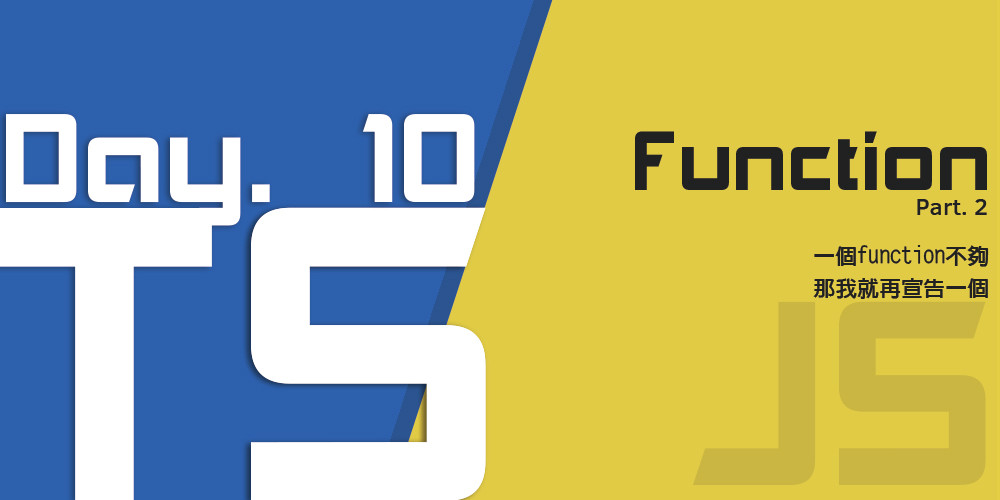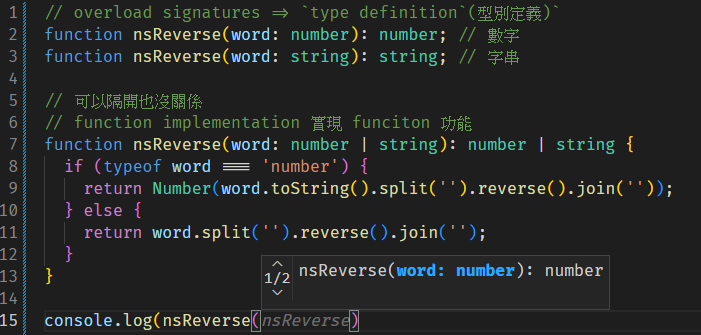[Day10] - 那我就再宣告一個 - Function part 2

沒想到還可以超載起來
一個function不夠?那我就再宣告一個。───────────────────────── By Opshell
目標: 學會 Function 的 Type法 Part2
今天來把剩下常用的function type 法來學完,
Alias(別名)、Interface(介面)和很酷的Overload(超載), 而且透過這些有趣的東西來稍微複習、熟悉我們前面學習的。
過程:
1. Alias(別名)
語法:
type 類型名稱 = (參數: 型別) => 型別;typescripttype tFullName = (firstname: string, lastname: string) => string; // 字首轉大寫 const upWord = (word: string): string => word.charAt(0).toUpperCase() + word.slice(1); const combinName: tFullName = (firstname, lastname) => { return `Hello ${upWord(lastname)} ${upWord(firstname)}, Welcome to typeScript.`; }; console.log(combinName('Liu', 'opshell')); // Hello Opshell Liu, Welcome to typeScript.1
2
3
4
5
6
7
8
9
10除了
Alias(別名)的範例以外, 順便複習了 箭頭函式 + 函式Inference(推論), 可以在 ts 中確認兩個函式的的型別,會有更多的了解和熟悉度。
2. Interface(介面)
和前面的
Alias(別名)非常的接近,在前一篇 funciton part 1 提到的, 等號賦值 +Inference(推論)的特性, 可以在上面Alias(別名)的例子和下面這個, 都可以很明顯看出這個特性, 不需要使用完整的型別陳述:typescriptinterface IFaceStrChk { (paragraph: string, keyword: string): boolean; } const checkKeyword: IFaceStrChk = (paragraph, keyword) => { // 如果再 Ts 中 查看paragraph 或 keyword 都會告訴你是string return paragraph.search(keyword) !== -1; } console.log(checkKeyword('Hello world !', 123)); // 報錯 類型number 無法指定給 string console.log(checkKeyword('Hello world !', 'llo')); // true console.log(checkKeyword('Hello world !', 'lle')); // false1
2
3
4
5
6
7
8
9
10
11
12
3. Overload (超載)
Overload(超載)允許一個函式接受不同數量或型別的引數時,作出不同的處理。 我們有一個反轉輸入的需求,做成一個函式 reverse, 輸入數字 123 的時候,輸出反轉的數字 321,輸入字串 'hello' 的時候,輸出反轉的字串 'olleh'。 我們會想到利用Union(聯集)型別:typescriptfunction reverse(word: number | string): number | string { if (typeof word === 'number') { return Number(word.toString().split('').reverse().join('')); } else if (typeof word === 'string') { return word.split('').reverse().join(''); } }1
2
3
4
5
6
7但
Union(聯集)輸入與輸出同時使用時有個問題,沒辦法精確的表達輸入與輸出的對應關係, reverse 在輸入數字的時候,輸出也應該是數字,輸入字串的時候,輸出也應該是字串。 這時候就可以使用Overload(超載)技巧。Overload(超載)會包含兩個部分:overload signatures:也就是函式輸入輸出對應的部分function implementation:實際上執行的 function,它的型別需要滿足所有的overload signatures
typescript// overload signatures => `type definition`(型別定義)` function nsReverse(word: number): number; // 數字 function nsReverse(word: string): string; // 字串 // 可以隔開也沒關係 // function implementation 實現 funciton 功能 function nsReverse(word: number | string): number | string { if (typeof word === 'number') { return Number(word.toString().split('').reverse().join('')); } else { return word.split('').reverse().join(''); } } console.log(nsReverse('aerg')); // grea1
2
3
4
5
6
7
8
9
10
11
12
13
14
15例子中重複定義了多次函式 reverse,前幾次都是函式對照定義,最後一次是函式實現。 成功使用函式
Overload(超載)之後,VSCode 的 會跳出提示來說明可用的function signatures※ VSCode 的parameter hints(鑲嵌提示)功能,可以這樣啟用它:在settings.json中添加: "javascript.inlayHints.parameterNames.enabled": "all",
※ 注意,TypeScript 會優先從最前面的函式定義開始匹配,所以多個函式定義如果有包含關係,需要優先把精確的定義寫在前面。
小結:
終於把Function Type法學完啦, 沒想到常用的 JS funciton 會有這麼多種花樣的 Type 方式,
居然讓我水了兩天明天就要進入Object的世界啦~ 大家期不期待呢?
章節小結:
沒想到跌跌撞撞的也到了第10天, 在這邊學到了
複合型別,Function(函式)的Type, 算是學到了個人覺得TypeScript中很常會使用到的部分, 各種Type法也越來越熟練了, 在每篇文章中都會重複的稍為提及一些較為複雜的東西, 讓大家可以對他們有個熟悉度, 在之後的章節中能夠更容易的上手, 如果現在看到,對他們還不是很熟悉也不用緊張喔~ 就讓我們下個章節見吧。

